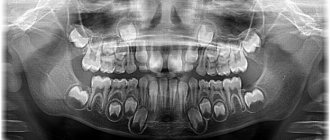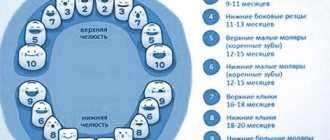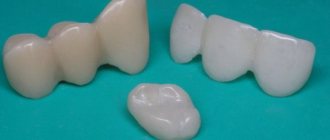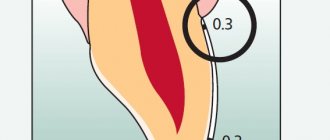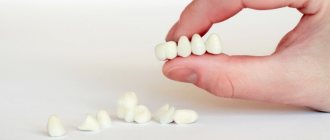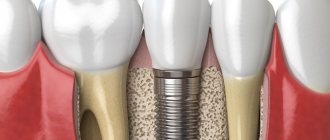O. S. Sarysheva pediatric dentist at the Denta Area clinic (Krasnodar)
There is no doubt that severely damaged teeth look unsightly and can become a source of pain for the child. Children, just like adults, pay attention to aesthetics. A child with decayed or discolored teeth often becomes an object of ridicule among his peers. This article will discuss the importance of restoring primary teeth in children.
Healthy and beautiful front teeth not only determine the child’s appearance, but also influence the pronunciation of sounds, and also contribute to social and psychological adaptation. Also important are the primary molars, which are involved in the chewing process, help hold space in the jaw for future permanent teeth, and create occlusal contacts.
The choice of restorative material for decayed primary teeth is very important. The material must be easy to use in practice, biocompatible, have a high limit of mechanical strength, but at the same time not cause premature wear of the antagonists, and, of course, the material must be aesthetic. Since we are talking about damaged temporary teeth, composite or GIC are not suitable for restoration. These materials are biocompatible and aesthetic, but in the case of volumetric restoration, they do not have the necessary mechanical strength. Over time, microcracks will appear at the tooth enamel/composite interface, which will contribute to microleakage and the development of complications in a previously treated tooth. Especially often in such cases, chips of the thinned walls of the tooth occur.
Is it possible to put crowns on baby teeth: a review of modern dentures that are suitable even for children
Article navigation
- Do children need crowns?
- Indications for installation
- In what cases should children not be given prosthetics?
- When can it be used
- What types of crowns are there for baby teeth?
- Popular brands of children's crowns
- How is the prosthesis installed?
- How long does the product last?
- How much does it cost to install dentures for baby teeth?
- Crown care
question to a specialist
The fact that baby teeth will “fall out anyway” gives many parents reason to treat their illnesses or removal with disdain – as a temporary nuisance. This is fraught with serious problems in the future, ranging from malocclusion and diction to gastrointestinal diseases. In such cases, prosthetics are indicated for adults, but do children get crowns on their baby teeth, and what types are they? This will be discussed further.
Children's dental prosthetics
Not only an adult, but also a child may encounter a situation where the only option for preserving teeth is prosthetics. In childhood, the installation of prostheses is indicated for the following conditions:
- for dental injuries (chips, dislocations, fractures);
- after removal due to caries;
- after removal due to non-carious pathologies: for example, due to fluorosis;
- after removal due to periostitis (flux), periodontitis;
- with early loss of a baby tooth;
- in case of tooth loss due to untimely treatment of bruxism.
In no case should you refuse prosthetics, since this is an excellent option to maintain normal bite, pronunciation and psychological comfort in children.
If you do not consult a dentist in time, the neighboring teeth may begin to move towards the missing one, filling the void. The permanent tooth will not have enough free space to grow, it will become curved, may grow outside the dental arch, and a pathological bite will form.
For the convenience of patients, detailed information is provided in the form of the most frequently asked questions and answers from Euromed pediatric dentists.
When is it necessary to install crowns on baby teeth?
Baby teeth are more susceptible to caries than permanent teeth. Some time after treatment of one, occlusal, surface of the tooth, there is a high probability of caries appearing on the other side. The decision on the need to restore baby teeth with crowns is made by the dentist after examining and diagnosing the patient’s teeth. The main indication for tooth restoration with crowns is the destruction of hard tissue by more than 50%. As a rule, these are all pulpitic and periodontitis teeth.
At what age can crowns be placed on baby teeth?
There are no age restrictions for having crowns installed.
Will a crown interfere with a change in bite?
Teeth with crowns fall out in the same way as during a physiological change in bite. The crown falls out along with the remainder of the baby tooth and filling material after the root has completely resolved.
Children's crowns for baby teeth: what are their advantages?
Crowns for baby teeth
- allow you to save temporary teeth until permanent teeth appear;
- minimize the risk of re-decay of baby teeth;
- prevent the development of diction defects in the child;
- form the correct bite;
- allow the child to chew food thoroughly;
- are hypoallergenic.
When restoring teeth with composite material, there is a risk of its depressurization. The filling material shrinks over time. In addition, he loves good hygiene. If a child doesn’t brush his teeth well, the material shrinks more and may fall out. This will not happen with crowns.
What crowns do Euromeda pediatric dentists use?
Euromed dentistry uses 3M stamped crowns. They are made of medical alloy and are hypoallergenic. The set contains 16 different sizes of caps for each tooth. This is very convenient because you can immediately select the size of the crown and fix it.
How are crowns installed?
It all starts with an examination and diagnosis of the child’s teeth. At this stage, the doctor assesses the condition of the teeth, determines the degree of their destruction and the possibility of using the structure. Then the doctor carries out the necessary treatment in accordance with the child’s problem - caries, pulpitis or periodontitis. Next, he selects a crown that is suitable in size, prepares the tooth for the crown, and then fixes the structure with special dental (glass ionomer) cement. This cement releases fluoride, which makes it possible to further strengthen children's teeth while wearing a crown.
How long does it take to install crowns?
Installing a crown is faster than filling a damaged tooth. In the process of tooth restoration with composite material, it is necessary to model the cusps. In the case of a crown, all this is not necessary. In addition, the crown does not need to be polished.
What is the service life of crowns?
It all depends on when the tooth was restored with a crown. If a child was given a structure at 3 years old (for example, on the 5th milk tooth, which will be replaced at 10 years old), then he will definitely go through 5-7 years with it. If a crown was placed on the same tooth at the age of 6, then it will last the child 4 years. And so on.
How much does it cost to restore baby teeth with crowns?
The cost of restoring a tooth with a crown is no different from restoring a tooth with filling material. For example, turnkey pulpitis treatment at Euromeda dentistry costs 3,400 rubles.
Do such structures require special care?
In terms of care, nothing changes: it is enough to brush your teeth twice a day for two minutes with a toothpaste with or without fluoride (as prescribed by the doctor) and come once every 6 months for a routine examination.
Do children need crowns?
First of all, dentures for primary teeth perform a protective function. Dentists are often faced with a situation where a small patient is treated repeatedly, because... baby teeth are very soft and inflammation spreads very quickly. As a result, the unit is destroyed anyway, and its remains have to be removed. The use of a crown prevents further infection of the tooth and its loss until it is replaced with a permanent one.
Why else do children get crowns?
- crowns prevent underdevelopment of the jaw bone tissue, which can be observed due to long-term lack of load on the bone,
- ensure normal eruption of permanent units - when one element is removed along with the root, the neighboring ones are displaced, as a result of which the new one may not have enough space (it begins to grow to the side or becomes impacted, i.e. does not show up at all),
- are the prevention of many gastrointestinal diseases, as they ensure normal chewing, and therefore digestion of food,
- ensure correct tongue positioning (the child feels the dentition) and normal speech quality.
Indications for prosthetic crowns
Typically, single crowns are used to restore severely damaged teeth. Among the medical indications, the following conditions are distinguished:
- destruction of the crown part of the tooth by half or more;
- increased abrasion and sensitivity of enamel;
- the need to correct the position or shape of the dental unit;
- fracture of the dental crown.
- tooth depulpation.
Installation of the prosthesis can be carried out on your own tooth, ground for a crown, or on a stump tab, which is previously fixed in the root.
The cost of prosthetics depends on the number of teeth to be treated, as well as the type of material used to make the crowns. Our clinic employs experienced and qualified dentists who, using modern equipment, will perform high-quality and inexpensive dental restorations even in the most complex clinical cases.
Indications for installation
Indications for restoring baby teeth with crowns are:
- destruction of a unit of dentition by more than half,
- underdevelopment of the enamel layer,
- trauma accompanied by damage to the coronal part,
- frequent loss of fillings, inability to fix them,
- enamel instability to mechanical stress, abrasion.
Installation of the product on baby teeth may also be required in orthodontics - as a support for the orthodontic apparatus (in older children).
Fissure sealing in children: pros and cons
A problem such as insufficient mineralization of fissures requires medical supervision. With the right approach, they can get the proper level naturally. For this reason, when deciding on the need to seal recesses on the surfaces of premolars and molars in children, CELT pediatric dentists practice an individual approach. Invasive sealing is similar to caries treatment: it requires opening the tooth before applying the composite. Compliance with all processes is important: even a small mistake can lead to the development of secondary caries, which cannot be detected under a layer of sealant. Such a tooth can completely collapse inside.
In what cases should children not be given prosthetics?
Almost all children can get crowns. The only contraindication is increased sensitivity to the materials used for their manufacture, but such situations are extremely rare. And, of course, age - it is permissible to install prostheses for children aged 2-3 years and older (earlier - unless there are very serious pathologies).
In addition, a specialist will not install a denture for a child if the process of root resorption has already affected 50% of the tissue. This phenomenon begins about a couple of years before the tooth falls out on its own, so installing a crown is pointless.
When can it be used
Children's crowns can be placed starting from the age of 2. Sometimes there are situations in which a specialist installs the structure earlier, for example, with congenital hypoplasia of the enamel layer. Each clinical case requires an individual approach, and determining the indications is within the competence of the doctor.
DENTAL PROSTHESIS ON 4 IMPLANTS - from RUR 170,000.
The price includes all procedures for installing Osstem implants (South Korea), including anesthesia and diagnostics.
Hurry up to sign up for a free consultation and fix your prices.
Call now or request a call
Opening hours: 24 hours a day - seven days a week
Advantages of installing crowns at clinic 20/32
Highly qualified specialists in pediatric dentistry “20/32” provide high-quality reconstruction with crowns of primary teeth at the best prices in Moscow.
Over the two years of operation, the clinic has earned a positive reputation thanks to its advantages:
- modern dental equipment;
- innovative equipment;
- application of the latest techniques and technologies;
- treatment is carried out by highly qualified specialists and many years of experience;
- quality provision of services;
- guarantee of results;
- individual approach to each child;
- affordable prices for services.
Treatment in pediatric dentistry “20/32” begins with a preliminary consultation. For the convenience of patients, an appointment is available on the clinic’s website when leaving a request for feedback (“Make an appointment”) or through dental consultants by contact phone number.
What types of crowns are there for baby teeth?
Crowns for children are produced in several types: metal, particularly durable, intended for the chewing group, metal with ceramic coating, plastic, all-ceramic, as well as strip crowns - caps of natural shades, which are installed mainly on the front teeth. As a rule, products are mass-produced and sold ready for use. But dentists also resort to making children’s dentures on their own, but they, of course, cost more than template models.
The peculiarity of materials for baby teeth is their plasticity and reliability of fixation, because the child’s teeth are in the growth stage - it is very important to install the prosthesis in such a way that it does not disrupt this process, so that it does not damage the germ of a permanent tooth, and so that it does not fly off at a crucial moment .
Metal products
Metal crowns for baby teeth come in different sizes and shapes, and they are installed in just one appointment. Despite the numerous advantages that the procedure provides, metal products have disadvantages. For example, there is a risk of developing an allergic reaction to the components included in the material (most often, nickel). In addition, when installed on the front units, such products do not look aesthetically pleasing. Therefore, metal crowns are most often used when teeth in the chewing group are damaged. An important disadvantage of metal is also that it is very hard, so it is not recommended to use it - it disables the antagonist teeth that are located on the opposite jaw.
Strip dentures (strip crowns)
Strip crowns are considered the most effective and simple way to preserve dental units in children. It is based on the use of acrylic and light-curing materials. This is a kind of celluloid cap; Available in sets of 16 pieces of various sizes.
Strip crowns are installed mainly on the anterior group. The products make it possible to preserve units of the dentition in case of pathologies of the enamel layer, injuries, carious destruction, and developmental defects. Their difference from crowns is that after the composite material has hardened, the cap is removed.
Ceramic products
These are standard ceramic crowns, which are also placed on children. But these are quite expensive products, especially considering that they should only last a few years. Such prostheses are created strictly individually in a laboratory.
Classic plastic
This is one of the most popular options - inexpensive, aesthetically pleasing and fast. Such crowns cope quite successfully with their functions and are created in a laboratory in just a couple of hours. They do not last long, but this is just optimal - they are quite enough to preserve the function of the entire jaw apparatus for the period until the permanent tooth grows.
Preparations for fissure sealing in children
During the procedure, the dentist treats the surface with a solution of phosphoric acid and thoroughly dries it, after which a sealant is applied on top, which forms a film. Sealant is a fissure sealant based on composite resins. It is designed to fill grooves and grooves and can be either light-curing or self-curing. After its application, the tooth surface becomes smoother, and the grooves, which previously could not be thoroughly cleaned with a toothbrush, are effectively sealed.
Thanks to this approach, the quality of oral hygiene rises to a new level, and the likelihood of caries development is minimized. Of course, parents should not forget that after the procedure, teeth cleaning should be carried out regularly, in a timely manner and with high quality. The cost of fissure sealing in children is much lower than the treatment of caries and pulpitis. The procedure itself is painless and does not require much time.
Our dentists seal fissures with special sealants of different colors. Children are delighted with them, and parents can easily monitor the condition of the chewing surface of molars and premolars. The procedure does not affect the bite and makes oral hygiene procedures more effective. The best way to do this is:
- At six to seven years - for permanent molars;
- At ten to eleven years old - for premolars;
- Up to thirteen years - for second permanent molars.
Popular brands of children's crowns
The range of children's crowns cannot be called wide. At the moment, the most widely used products are from two manufacturers:
- NuSmile – are highly aesthetic, durable, and hypoallergenic. Products of this brand are popular not only in pediatric dentistry, but also in adult dentistry. The structures are made of metal and covered with ceramics,
- 3M ESPE DENTAL - the company presents both crowns and caps (strip dentures). For production, the manufacturer uses special alloys that are biologically compatible with living tissue. In pediatric dentistry, nickel-chrome products are installed on the chewing group, and zirconium ceramics are installed on the anterior units of the dentition.
“When the child damaged his front teeth, I didn’t know whether it was possible to get crowns or whether they would have to be removed. It’s good that the doctor himself suggested it. White, smooth, like your own. Now the child is happy, and I am calm.”
Valentina R., from a review from babyblog.ru
Removable dentures in children:
Bridges
Sliding bridges for replacing several molars or incisors in a child.
Lamellar dentures
A patient-friendly option in the absence of lateral and anterior units.
Immediate dentures, “butterfly”
Nylon replacement of one or two teeth with fixation on adjacent units with clasp hooks.
Complete dentures
Necessary for toothless jaws in a child and have an elastic lining for ease of wearing and physiological comfort.
How is the prosthesis installed?
In general terms, the procedure can be described in the following steps:
- pain relief with individually selected means,
- cleaning the tooth surface from deposits,
- removing a thin layer of tissue from the chewing surface (but not much to preserve the integrity of the tooth),
- selection and fitting of the crown / or taking impressions if a laboratory manufacturing method is used,
- fixation of the crown with a permanent composition,
- sanding and adjustment if necessary.
The duration of the procedure is about half an hour - because the child will not be able to sit longer. That is why template models of crowns are most often used, which doctors have in stock for all occasions (meaning, for all types and sizes of teeth). If necessary, before installation, the doctor carries out treatment - removal of caries or even a nerve, if required.
How long does the product last?
A crown remains on temporary teeth until they fall out. To keep the tissue condition under control, you will need to visit the dentist 2 times a year. They have absolutely no effect on the change in bite and fall out along with the tooth, because they are fixed very securely.
Complex on 4 OSSTEM implants with delayed loading - from RUB 170,000.
Complex implantation Osstem (South Korea) with delayed loading after 4-6 months.
Guarantee for the doctor’s work - unlimited Call now or order a call
Opening hours: 24 hours a day - seven days a week
Preparation and installation process
Children's crowns are installed in one visit to the dentist's office. To avoid discomfort, all manipulations are performed under an anesthetic. Before installation, at the preparatory stage, the carious lesion is eliminated (using a drill). For control purposes, a marker is used - this is a liquid that intensively changes shade during contact with carious tissues.
After this, plaque is removed using a special brush and polishing paste. Hardware methods can seriously damage the enamel, so they are not used. The future design is selected before caries is eliminated. The shape and size of the molar or premolar to be restored is taken into account. No impressions are required. Below is an example of installing a strip crown. It takes place in several stages:
- isolation of the tooth from saliva with cotton rolls;
- shortening the structure by several mm using a diamond bur, which gives it a conical shape;
- minor grinding of healthy tissues (to maintain a natural bite);
- selection of product shade depending on the natural shade of enamel;
- filling the cap with composite (a small depression is formed so that most of the composite does not leak out of the structure);
- treating the tooth surface with acid (this significantly improves adhesion), after which it is washed and dried;
- putting on a cap;
- removing excess material with a spatula;
- illumination of the composite using a special lamp;
- smoothing and grinding of the crown.
The crown will fall out along with the tooth when the root resolves
Crown care
Diet and regular, proper oral hygiene are very important here. It is necessary to avoid hard foods that can lead to chipping of the crown - it is important to exclude crackers, dryers, and candies. If possible, it is also necessary to protect children from injuries and from bad habits of gnawing on everything. Yes, it will be difficult, but this is exactly what will allow you to keep your teeth with crowns safe and sound.
Author: Mikhailova (. M. (Thank you for your help in writing the article and the information provided)
